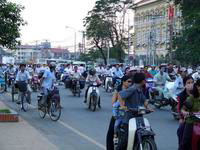 Ho Chi Minh City OverviewHo Chi Minh City, better known by its former name of Saigon, is
a brazen, industrious and dense metropolis, the largest city in
Vietnam and the business capital of the country. With a population
of five million, it is crowded, noisy and dirty, yet it is also
exciting and historic, the essence of the nation. Located on the Saigon River on the edge of the Mekong Delta,
Saigon became the capital of the Republic of South Vietnam and was
the American headquarters during the Vietnam War. Two years later
the Communist north took control of the country, the city's name
was changed to Ho Chi Minh City, and recession and poverty
ensued. Today Ho Chi Minh City has a cosmopolitan and energetic
atmosphere, and having actively welcomed the new capitalist
principle, the business-minded spirit of the people is much in
evidence. Although relatively modern, it has still managed to hold
onto its Asian character, and fine restaurants, smart hotels and
chic bars line the sidewalks crammed with noodle stands, markets
and shoeshine boys. The buzzing of motorbikes and scooters merges
with the cries of street vendors and the urgent business of stall
owners, selling barbecued dog, writhing snakes and tropical fruits.
The sight of a family of four balanced precariously on a scooter, a
squealing pig strapped onto the back of a bicycle, bowed heads
topped by pointed lampshade-style hats and orange-clothed monks are
just some of the vibrant images the city has to offer. Although overshadowed by modern and Asiatic influences, a little
of Ho Chi Minh City's French colonial charm still remains, evident
in the graceful architecture, wide boulevards, and a sidewalk cafe
society. It is not for the attractions that one visits Ho Chi Minh
City however, but for the vibrancy of its street life, and its
proximity to the Mekong Delta. |